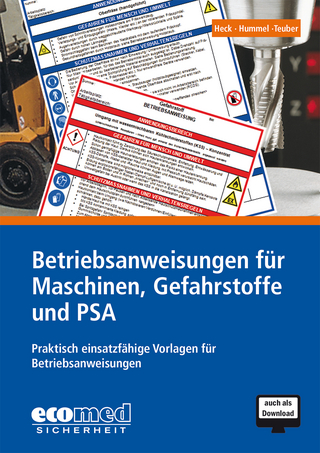
Wind Flow and Vapor Cloud Dispersion at Industrial and Urban Sites
Wiley-Blackwell (Hersteller)
978-0-470-93561-3 (ISBN)
- Keine Verlagsinformationen verfügbar
- Artikel merken
*Providing the appropriate roughness inputs to transport and dispersion models depending on conditions. *Demonstrating the application of these techniques through worked examples.
Steven R. Hanna is the author of Wind Flow and Vapor Cloud Dispersion at Industrial and Urban Sites, published by Wiley. Rex E. Britter is the author of Wind Flow and Vapor Cloud Dispersion at Industrial and Urban Sites, published by Wiley.
Preface. Acknowledgments. List of Symbols. 1. Introduction. 1.1 Background. 1.2 Objectives of This Book. 1.3 Overview. 1.4 Definition of Scenarios and Modeling Scales. 2. Overview of Meteorology and Atmospheric Dispersion. 2.1 Definitions of Concepts and Terms. 2.2 Engineering Background. 2.3 Surveys of Currently Available Methods for Classifying Dispersion Coefficients for a Variety of Surface Types. 2.3.1 Introduction to Discussion of Effects of Surface Features. 2.3.2 Use of Simple Gaussian Dispersion Model to Understand the Effects of Roughness. 2.3.3 Situations Where Winds, Stability and Underlying Terrain Vary in Time and/or Space. 2.3.4 Methods for Accounting for Surface Roughness Length and Displacement Length in Dispersion Models. 2.4 Survey of Experiments Showing Effects or Surface Roughness Obstacles on Dispersion. 2.4.1 Dispersion of Clouds with Mass-Weighted Mean Heights Greater Than the Roughness Obstacle Height, H r . 2.4.2 Dispersion of Clouds with Mass-Weighted Mean Heights Less Than the Roughness Obstacle Height, H r . 3. Methods for Characterizing the Effects of Surface Roughness Obstacles on Flow. 3.1 Required Flow Characteristics for Input to Transport and Dispersion Models. 3.2 Consideration of Flow Above and Below the Tops of the Obstacles. 3.3 Flow above the Surface Roughness Obstacles. 3.3.1Definition of Surface Roughness Length z o , and Displacement Length, d, as They Relate to Flow Characteristics Such as Wind Speed. 3.3.2 Methods for Estimating z o and d from Wind Observations. 3.3.3 Size of Surface Area that Influences Flow at a Given Height. 3.3.4 Estimation of z o and d Based on Knowledge of Surface Roughness Obstacles' Dimensions and Geometric Relations (the Morphological Method). 3.3.5 Overview of Land Use Category Methods for Estimating z o and d. 3.3.6 Estimation of z o for Surface Conditions Varying in Space. 3.4 Flow Through an Obstacle Array. 3.4.1 Extent of the Roughness Sublayer. 3.4.2 Wind Velocity Fields within and Near Obstacle Arrays. 3.4.3 Model Comparison with Experimental Data. 3.4.4 The Turbulence Field within the Obstacle Array. 3.4.5 Extensions to Other Effects within the Obstacle Array. 3.4.6 Summary of Recommendations for Wind Speed and Turbulence within the Obstacle Array. 3.5 Summary of Recommended Methods for Estimating z o , d, and Flow Characteristics Such as Wind Profiles, Friction Velocity (u*), and Turbulence Velocities in Urban and Industrial Areas. 3.5.1 Definition of Region of Interest (from Source to Receptor), 3.5.2 Determination of z o and d. 3.5.3 General Simple Formulas for u*, u(z), and Turbulent Velocities. 3.5.4 Selection of an Appropriate Mean Wind Speed and Stability. 3.5.5 Estimates of Urban and Industrial Geometric Parameters H r , lambda f , and lambdap Using the ROUGH Code. 3.5.6 Range of Uncertainty in Estimates of z o , d, u*, u(z), and Turbulent Velocities. 4. Integration of Roughness into Dispersion Models. 4.1 Objectives and Fundamental Physical Concepts. 4.2 Dispersion Models for Clouds Extending Above H r . 4.2.1 Introduction to General Characteristics of Models. 4.2.2 Summary of Dispersion Experiments over Rough Surfaces. 4.2.3 Gaussian Plume and Puff Model. 4.3 Dispersion Models for Clouds below H r . 4.3.1 The Cloud Velocity, u e oru,sub>avg, below H r . 4.3.2 The Vertical Plume Dimension sigma z below H r . 4.3.3 The Lateral Plume Dimension sigma y below H r . 4.3.4 The Along-Wind Puff Dimension sigma x below H r . 4.3.5 The Effect of u c , sigma x and sigma y and sigma z on the Concentration at Heights below H r . 4.3.6 Extension to Positively and Negatively Buoyant Releases below H r . 4.4 Transition Methods for Clouds of Height Close to H r within the Urban Roughness Sublayer. 4.5 Summary and Recommendations. 4.5.1 Dispersion Models for Clouds extending above H r . 4.5.2 Dispersion Models for Clouds Released above or Near H r . 4.5.3 Dispersion Models for Clouds below H r . 4.5.4 Dispersion Models for Scenarios Where the Upwind and Downwind Roughness Is Different. 4.5.5 Dispersion Models for Clouds Released Upwind of the Roughness and Traveling into and through the Roughness. 5. Worked Examples of Calculations of Surface Roughness Length for Seven Industrial and Urban Scenarios. 5.1 Case I: Small (18 m by 24 m) Industrial Plant. 5.2 Case 2: A Group of Industrial Warehouses Covering a 250 m by 250 m Area. 5.3 Case 3: Medium-Sized (400 m by 400 m) Refinery. 5.4 Case 4: Typical Urban Area (Chicago). 5.5 Case 5: Industrial Plant (Case 3) in Chicago Urban Area. 5.6 Case 6: Industrial Plant from Case 3 Located on a Peninsula. 5.7 Case 7: Large 4 km by 4 km Refinery in a Desert. 5.8 Summary of Seven Cases Used for Worked Examples. Appendix: Text Files for CD-Rom with z o Estimation Codes. ROUGH-GEOMETRY User's Guide. ROUGH-ZO User's Guide. References. Glossary. Index.
| Erscheint lt. Verlag | 26.8.2010 |
|---|---|
| Verlagsort | Hoboken |
| Sprache | englisch |
| Maße | 162 x 233 mm |
| Gewicht | 562 g |
| Themenwelt | Naturwissenschaften ► Chemie ► Technische Chemie |
| Technik ► Umwelttechnik / Biotechnologie | |
| ISBN-10 | 0-470-93561-8 / 0470935618 |
| ISBN-13 | 978-0-470-93561-3 / 9780470935613 |
| Zustand | Neuware |
| Haben Sie eine Frage zum Produkt? |
aus dem Bereich
